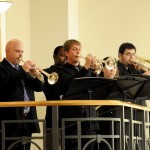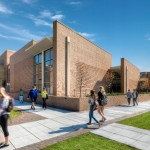J.S. Bach The Gamba Sonatas Liner Notes
J.S. Bach: The Gamba Sonatas
The sonatas for viola da gamba and harpsichord were almost certainly composed at Leipzig during the last 20 years of Bach’s life. In modern times they are usually offered as a set, both in print and in recording, merely because of their instrumentation. But they were conceived independently from one another, perhaps for the Leipzig Collegium Musicum performances Bach conducted between 1729 and 1741 at Zimmerman’s Coffee House. This concert series was a major focus of Bach’s musical life in the 1730’s. The gamba sonata scores originate between 1736 and 1741, a period when Bach was deeply involved in chamber music.
Sonata BWV1027 in G major is almost certainly a transcription of a previous sonata for two flutes and harpsichord, BWV1039, and is the only one of the three gamba sonatas whose autograph is extant.
Sonata BWV1028 in D major
Sonata BWV1029 in G minor is cast in the traditional, three-movement grand Italian concerto form and may well be an arrangement of a previous concerto, perhaps a lost seventh Brandenburg Concerto?
These sonatas are a graphic representation of Bach’s philosophy, not just of music, but of the purpose of life. Bach saw the world as created, ordered and logical. His art reflected his cooperation in this system and he apprehended learned counterpoint as the preeminent brush for painting the natural world through music. In his mind it is counterpoint, two or more melodies moving together, that create vertical relationships, harmony, and spatial relationships, rhythm. The gamba sonatas recorded here present three, distinct melodies: trombone, and in the keyboard, right hand and left hand. These voices moving together exemplify much more than the demonstration of Bach’s mastery of musical construction; he was not interested in purely abstract goals. He sought to prove the existence of God, to relate truth, to represent the natural order of the world. Knitting together the melodies in counterpoint create an aesthetic reality only implied by any single voice, a reality that exists and merely awaits discovery through counterpoint. Indeed, Bach expressed the depths of his faith through learned counterpoint and it is the Mass in B Minor and Art of Fugue that arguably represent his most profound compositions. The gamba sonatas are incidental by comparison but the astounding craft and creativity in them demonstrate the depths at which Bach integrates theory with practice.
Performing on trombone
These sonatas present real problems for the trombonist. Chief among them are the extended phrase lengths and continuous nature of Bach’s counterpoint. Rest is precious to the brass player and these sonatas afford little. Extended range is also a great challenge to the trombonist as is the dexterity required in fast movements and in ornamentation. But the majestic sound of the trombone imbues this great music with the spirit of a mighty steed.
This project is made possible through the generous support of the Kansas University Center for Research General Research Fund. Special thanks to Rebecca Bell, Paul Eachus, Oliver Finney, Father Vince Krische, Brittany Rank, Masa Ohtake.
Recorded May 23-25, 2005 at Saint Lawrence Catholic Campus Center, Lawrence, Kansas USA. Produced and engineered by Paul Eachus, Best Classical Recording. Harpsichord technician, Oliver Finney.
Instruments: Conn 36h E-flat alto trombone with B-flat/A valve attachment. Greg Black standard weight, custom mouthpiece, similar in internal size and shape to Bach 18. Harpsichord: Michael Johnson 2004. Tuning: 440Hz.
Microphones: Bruel & Kjaer 4003, Neumann TLM 193, Km 184. Console: DDA. Analog to Digital Converter: Lexicon 20/20.
This project is made possible through the generous support of the Kansas University Center for Research General Research Fund. Mike Hall is a C.G. Conn and Selmer Bach performing artist.
MIKE HALL is Assistant Professor of Trombone at the University of Kansas, appointed fall 2000, and serves as Literature Reviews Editor for the International Trombone Association Journal. From 1995–2000, he was Lecturer of Low Brass and director of the Jazz Ensemble Program at Eastern Michigan University. He has received the Doctor of Musical Arts degree in trombone performance from the University of Minnesota, the Master of Music degree in trombone performance from the University of Arizona, and the Bachelor of Music Education degree from the University of Wisconsin-Stevens Point. His principal teachers include Thomas Ashworth, Tom Ervin, Vern Kagarice, and Brian Martz. Dr. Hall has performed extensively throughout the United States, Mexico, Europe and China covering a large spectrum of styles, including appearances with the symphony orchestras of Kansas City, Ann Arbor, Detroit, Tucson, Arizona Opera, and Kharkiv, Ukraine. As a chamber musician Dr. Hall currently serves as trombonist for the Kansas Brass Quintet and from 1995-2000 he performed as member of the Galliard Brass Ensemble based. During that time he also gave many performances with the Detroit Chamber Winds and Michigan Chamber Brass. As a studio musician Dr. Hall has recorded several motion picture sound tracks, television and radio commercials, and compact disc projects. As a soloist he gives recitals and masterclasses throughout the U.S. and Europe. This recording is the second in a long-term program of research that will contribute solutions, new techniques, and suggestions of melodic embellishment to trombone repertoire of the Baroque era. The first, Arcangelo Corelli Solo Chamber Sonatas Opus 5, was released in 2004.
REBECCA BELL studied at the Royal College of Music, London, where she won the prize for clavichord playing while studying with Ruth Dyson and Robert Woolley. She performs with the Kansas City Symphony and the Kansas City Chamber Orchestra and with the opera studio of Bill Hall. Other recording projects include a compact disc of Bach flute sonatas with former Kansas City flutist Lamar Hunt Jr., and she is featured on A Heartland Morning, A Heartland Afternoon, a sampler of Kansas City artists. She is a member of the American Guild of Organists and organist at All Saints Episcopal Church, Kansas City, MO.


